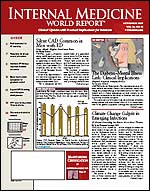Publication
Article
Internal Medicine World Report
Adding EPA Supplements to Statin Therapy Reduces Recurrent Coronary Events
Adding EPA Supplements to Statin Therapy Reduces Recurrent Coronary Events
Dallas—Supplementation with omega-3 fatty acids (fish oil) in the form of highly purified eicosapentaenoic acid (EPA) capsules together with statin therapy leads to a decrease in major coronary events compared with statin therapy alone in hypercholesterolemic patients.
Findings announced at the American Heart Association’s Scientific Sessions 2005 reveal a significant clinical benefit of the combination in secondary prevention and a similar but insignificant trend toward benefit in primary prevention over 4.5 years of treatment.
“We speculate that the benefit is not mediated by cholesterol-dependent mechanisms but may be related to plasma levels of EPA and the EPA:arachidonic acid [AA] ratio,” said lead investigator Mitsuhiro Yokoyama, MD, PhD, chief, Division of Cardiovascular and Respiratory Medicine, Kobe University Graduate School of Medicine, Kobe, Japan.
Some 18,645 patients with hypercholesterolemia who were already being treated with a statin were randomized to either 1800 mg/day of highly purified EPA capsules or placebo.
The primary end point was a composite of sudden cardiac death, fatal and nonfatal myocardial infarction, and unstable angina that included hospitalization for ischemic episodes and the need for angioplasty/stenting or coronary artery bypass graft surgery.
At a mean follow-up of 4.6 years, the primary end point was observed in 19% fewer patients assigned to the EPA capsules (2.8% vs 3.5%; P = 0.0113).
Low-density lipoprotein cholesterol levels declined by 26% in each group and high-density lipoprotein cholesterol levels increased by 5% and 3% in the EPA and placebo groups, respectively.
Measurement of the plasma fatty acids ratio revealed an improvement in the AA ratio from 0.63 at baseline to 1.23 at study’s end in the EPA group and no change in the placebo group (.60 at baseline vs .59 at the end of the study).
Patients were stratified into a primary prevention group, which included 14,981 patients with no history of coronary artery disease (CAD), and 3664 patients with a history of CAD. In the secondary prevention group, the event rates for the primary end point were 8.7% in the EPA group and 10.7% in the placebo group, corresponding to a significant 19% reduction in risk (P = .0476). The reduction in risk was a similar 18% in the secondary prevention group but this reduction in risk failed to achieve statistical significance (P = .1318) owing to the few number of events in this group overall.
Extrapolating the results to a western population is difficult, given the difference in risk background between Japanese and western populations, said Dr Yokoyama. The Japanese diet consists of about 40% fish, and vascular disease rates are lower in Japan compared with western populations, he said.
The dose of EPA used in this study—1800 mg/day—is much greater than the dose in a standard over-the-counter (OTC) supplement, said Lawrence Appel, MD, of Johns Hopkins University, Baltimore, Md. “OTC preparations have 0.18 g of fish oil, and the amount used in this trial was 10 times this amount,” he said.
To achieve 1800 mg/day of EPA would require prescription-strength capsules, he said.
Fish oil capsules have documented evidence of benefit in previous secondary prevention trials, he noted, with uncertain benefits in primary prevention, much like Dr Yokoyama’s study. The mechanism behind the benefit has yet to be elucidated, although the triglyceride-lowering effect of high-dose EPA may play a role, said Dr Appel. —W.K.
